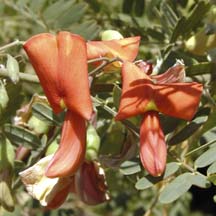
In the Garden![]()
Rick Barboza
OHAI
LATIN NAME
Sesbania tomentosa form arborea
Ohai (Tree Variety) Description: Small, upright trees 10 to 18 feet tall with evenly pinnate leaves, meaning they have an even number of leaflets on each compound leaf. Young leaves also have shiny, golden surface hairs, an evolutionary adaptation to help reflect the sun and prevent them from drying out. This hairiness is referred to as tomentos, which is how this plant got its species name.
Ohai flowers are 2 inches long and shaped like pea flowers. They emerge in clusters of about two to five and are a bright orange with varying streaks of yellow and red. Narrow seed pods filled with small green and dark brown seeds form when the flowers are pollinated.
Distribution: Ohai is found on all the main islands, as well as Nihoa and Necker in the Northwestern Hawaiian Islands. Each island's populations varies significantly in morphology (physical appearance), yet are all treated as the same species.
Generally, all are either low prostrate crawlers or small shrubs growing no more than 3 feet tall. They generally live near the coast in sunny, dry locations and all are endangered. This variety is the most significant in that it is found only on Molokai and in addition to being three to five times taller than the rest of the pack, its natural range encompasses a higher elevation than the rest, though still confined to dry habitats.
Cultural uses: This plant's beautiful flowers are used to make lei and can be strung in the same style as the Maunaloa-type lei.
Landscape use and care: These small trees look great in landscapes and can be planted as specimens or in rows. Being such a small tree, their flowers are usually at eye-level, which make viewing them very easy. Plant them in full sun and in soil that dries easily. These plants are very sensitive to over watering and will usually have yellow leaves that eventually wilt and fall off if over watering occurs.
Also, look out for shiny black stink bugs that may be on the plant. They look like black and gold lady bugs, but trust me, they're not. No lady would ever dish out a smell like that. Generally, the insects don't harm the plant but you can get rid of them by shooting the plant with water or by spraying it with a mild pesticide.
More information: As stated above, all forms of this species are considered endangered species. This is primarily because their natural habitat has been destroyed for decades by development or destruction from off-road vehicles.
Gardening Calendar


